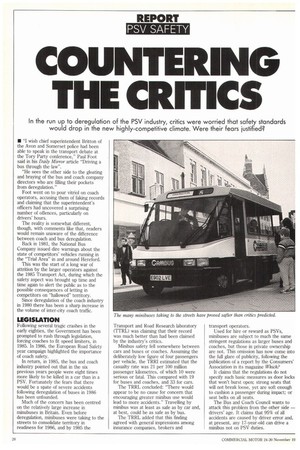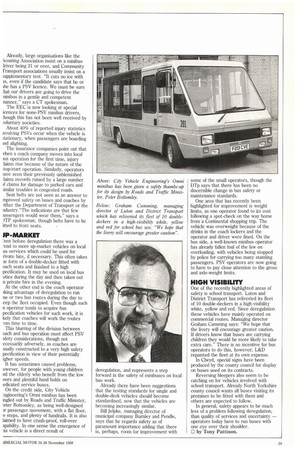COUNTERING THE CRITICS
Page 24

Page 25

If you've noticed an error in this article please click here to report it so we can fix it.
In the run up to deregulation of the PSV industry, critics were worried that safety standards would drop in the new highly-competitive climate. Were their fears justified?
• "I wish chief superintendent Britton of the Avon and Somerset police had been able to speak in the transport debate at the Tory Party conference," Paul Foot said in his Daily Mirror article "Driving a bus through the law".
"He sees the other side to the gloating and braying of the bus and coach company directors who are filling their pockets from deregulation."
Foot went on to pour vitriol on coach operators, accusing them of faking records and claiming that the superintendent's officers had uncovered a surprising number of offences, particularly on drivers' hours.
The reality is somewhat different, though, with comments like that, readers would remain unaware of the difference between coach and bus deregulation.
Back in 1981, the National Bus Company issued dire warnings about the state of competitors' vehicles running in the "Trial Area" in and around Hereford.
This was the start of a long war of attrition by the larger operators against the 1985 Transport Act, during which the safety aspect was brought up time and time again to alert the public as to the possible consequences of letting in competitors on "hallowed" territory.
Since deregulation of the coach industry in 1980 there has been a sharp increase in the volume of inter-city coach traffic.
LEGISLATION
Following several tragic crashes in the early eighties, the Government has been prompted to rush through legislation, forcing coaches to fit speed limiters, in 1985. In 1986, the European Road Safety year campaign highlighted the importance of coach safety.
In return, in 1985, the bus and coach industry pointed out that in the six previous years people were eight times more likely to be killed in a car than in a PSV. Fortunately the fears that there would be a spate of severe accidents following deregulation of buses in 1986 has been unfounded.
Much of the concern has been centred on the relatively large increase in tninubuses in Britain. Even before deregulation, minibuses were taking to the streets to consolidate territory in readiness for 1986, and by 1985 the Transport and Road Research laboratory (TTRL) was claiming that their record was much better than had been claimed by the industry's critics.
Minibus safety fell somewhere between cars and buses or coaches. Assuming the deliberately low figure of four passengers per vehicle, the TRRI estimated that the casualty rate was 21 per 100 million passenger kilometres, of which 10 were serious or fatal. This compared with 19 for buses and coaches, and 33 for cars.
The TRRL concluded: "There would appear to be no cause for concern that encouraging greater minibus use would lead to more accidents." Travelling by minibus was at least as safe as by car and, at best, could be as safe as by bus.
The TRRL added that this finding agreed with general impressions among insurance companies, brokers and transport operators.
Used for hire or reward as PSVs, minibuses are subject to much the same stringent regulations as larger buses and coaches, but those in private ownership are not. This omission has now come into the full glare of publicity, following the publication of a report by the Consumers' Association in its magazine Which?
It claims that the regulations do not specify such basic measures as door locks that won't burst open; strong seats that will not break loose, yet are soft enough to cushion a passenger during impact; or seat belts on all seats.
The Bus and Coach Council wants to attack this problem from the other side — drivers' age. It claims that 95% of all accidents are caused by driver error and, at present, any 17-year-old can drive a minibus not on PSV duties. Already, large organisations like the 3couting Association insist on a minibus iriver being 21 or over, and Community Transport associations usually insist on a supplementary test. "It cuts no ice with is, even if the candidate says that he or the has a PSV licence. We must be sure hat our drivers are going to drive the ninibus in a gentle and competent nanner," says a CT spokesman.
The EEC is now looking at special icences for none-PSV minibus drivers, hough this has not been well received by roluntary societies.
About 40% of reported injury statistics nvolving PSVs occur when the vehicle is ;tationary, when passengers are boarding md alighting.
The insurance companies point out that vhen a coach company moves into local ius operation for the first time, injury :lairns rise because of the nature of the ;top/start operation. Similarly, operators iave seen their previously unblemished :laims records ruined by a large number if claims for damage to parked cars and limilar troubles in congested roads.
Seat belts are not seen as an answer to mproved safety on buses and coaches by tither the Department of Transport or the ndustry."The indications are that few iassengers would wear them," says a )TP spokesman, though belts have to be itted to front seats.
JP-MARKET
:yen before deregulation there was a rend to more up-market vehicles on local us services which could be used for rivate hire, if necessary. This often takes le form of a double-decker fitted with oach seats and finished to a high pecification. It may be used on local bus uties during the day and then taken out n private hire in the evening.
At the other end is the coach operator iking advantage of deregulation to run ne or two bus routes during the day to eep the fleet occupied. Even though such
n operator tends to acquire bus pecification vehicles for such work, it is kely that coaches will work the routes -om time to time.
This blurring of the division between oach and bus operation must affect PSV afety considerations, though not ecessarily adversely, as coaches are sually constructed to a very high safety pecification in view of their potentially igher speeds.
It has sometimes caused problems, owever, for people with young children nd the elderly who benefit from the low oars and plentiful hand holds on edicated service buses.
On the credit side, City Vehicle ;ngineering's Omni minibus has been ingled out by Roads and Traffic Minister, 'eter Bottomley, as being well-designed w passenger movement, with a flat floor, o steps, and plenty of handrails. It is also 'aimed to have crush-proof, roll-over apability. In one sense the emergence of is vehicle is a direct result of deregulation, and represents a step forward in the safety of minibuses on local bus work.
Already there have been suggestions that the testing standards for single and double-deck vehicles should become standardised, now that the vehicles are becoming increasingly similar.
Bill Jelpke, managing director of municipal company Burnley and Pendle, says that he regards safety as of paramount importance adding that there is, perhaps, room for improvement with some of the small operators, though the DTp says that there has been no discernible change in bus safety or maintenance standards.
One area that has recently been highlighted for improvement is weight limits, as one operator found to it cost following a spot-check on the way home from a Continental shopping trip. The vehicle was overweight because of the drinks in the coach lockers and the operator and driver were fined. On the bus side, a well-known minibus operator has already fallen foul of the law on overloading, with vehicles being stopped by police for carrying too many standing passengers. PSV operators are now going to have to pay close attention to the gross and axle-weight limits.
HIGH VISIBILITY
One of the recently highlighted areas of safety is school transport. Luton and District Transport has reliveried its fleet of 10 double-deckers in a high-visibility white, yellow and red. Since deregulation these vehicles have mainly operated on commercial routes. Managing director Graham Cumming says: "We hope that the livery will encourage greater caution. If drivers know that buses are carrying children they would be more likely to take extra care." There is no incentive for bus operators to do this, however; L&D repainted the fleet at its own expense.
In Clwyd, special signs have been produced by the county council for display on buses used on its contracts.
Reversing bleepers also seem to be catching on for vehicles involved with school transport. Already North Yorkshire county council wants all buses visiting its premises to be fitted with them and others are expected to follow.
In general, safety appears to be much less of a problem following deregulation, than quality of services and uncertainty — operators today have to run buses with one eye over their shoulder.
CI by Tony Pattison.










































































































